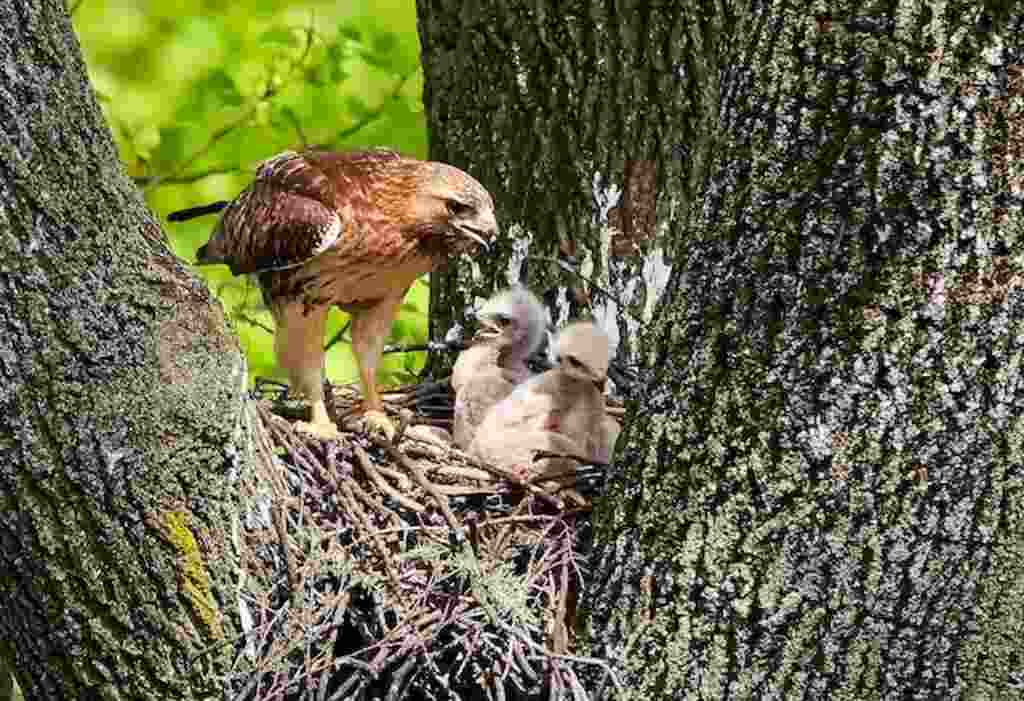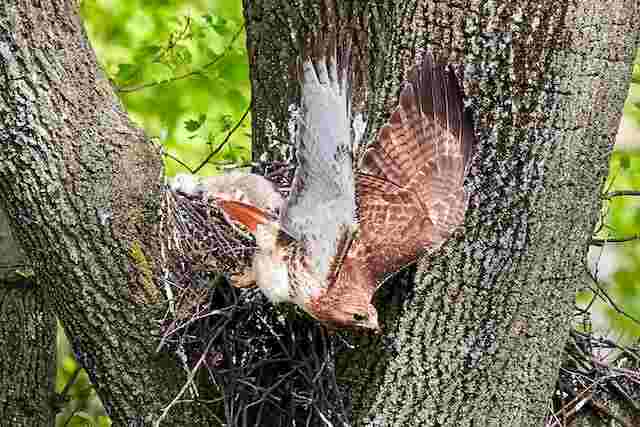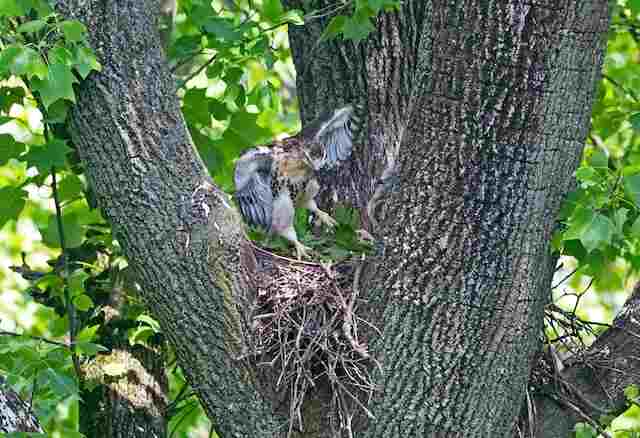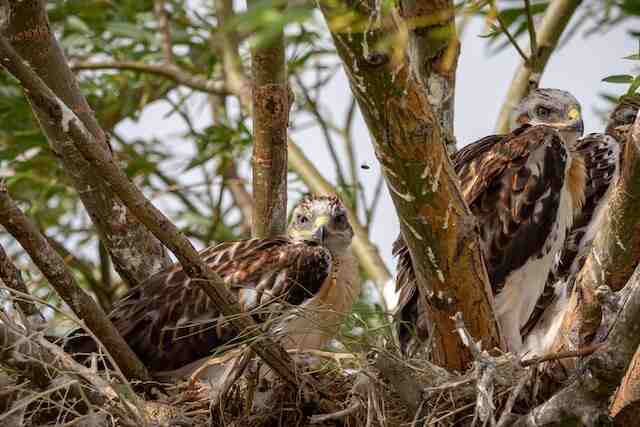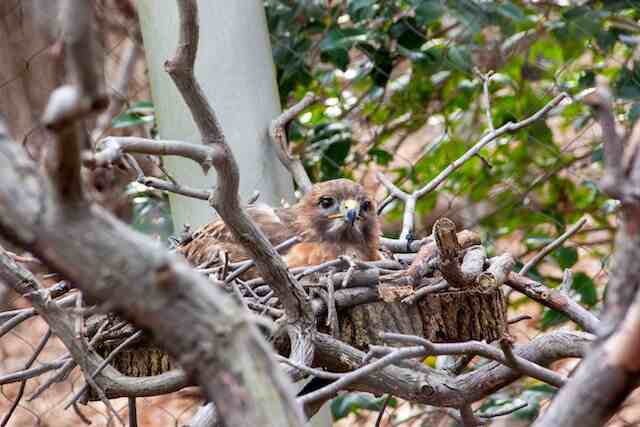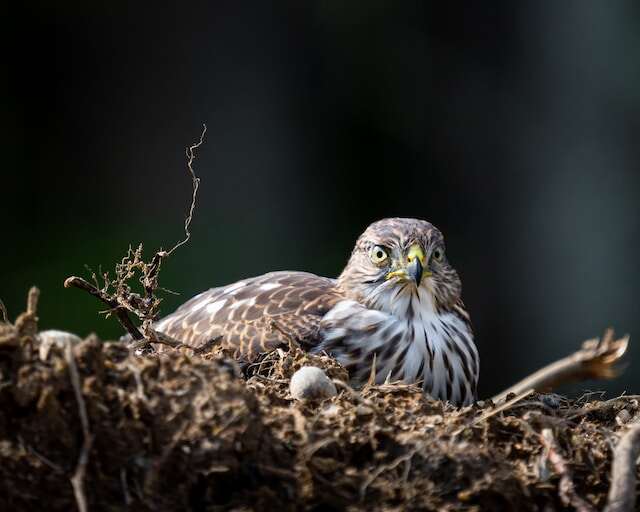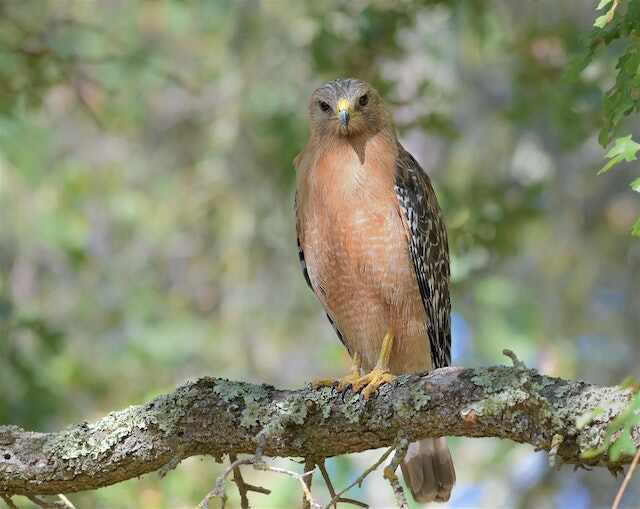How Do Hawks Care for Their Young? Discover the secret world of hawk parenting! From building extravagant nests to aerial acrobatics in the hunt for food, these magnificent birds of prey have a lot to teach us about family values.
Prepare to be amazed as we delve into their extraordinary parenting behaviors and learn why hawks truly soar above the rest.
Get ready to spread your wings and dive into the captivating world of hawk parenthood!
Table of Contents
- 1 The Importance of Hawks in the Ecosystem and Their Parenting Behaviors
- 2 How Do Hawks Care for Their Young?
- 3 Nest Building
- 4 Egg Laying and Incubation
- 5 Feeding Young Hawks
- 6 Protection from Predators
- 7 Fledgling Period
- 8 Conclusion
- 9 FAQs: How Do Hawks Care for Their Young?
- 9.1 How do hawks build their nests?
- 9.2 When do hawks lay their eggs?
- 9.3 How long does incubation take for hawk eggs?
- 9.4 What do hawks feed their young?
- 9.5 How do hawks protect their nests from predators?
- 9.6 When do young hawks leave the nest?
- 9.7 How do hawks teach their young to hunt?
- 9.8 What threats do young hawks face in the wild?
- 9.9 Why are hawks important in the ecosystem?
- 9.10 How can we protect hawks and their young?
- 10 Author
The Importance of Hawks in the Ecosystem and Their Parenting Behaviors
Hawks, which are also known as raptors, are birds of prey that belong to the Accipitridae family. They are known for their keen eyesight and powerful talons, which they use to catch and kill their prey.
Hawks play an important role in the ecosystem by helping to control populations of rodents and other small animals.
They are also indicators of environmental health, as they require clean air and water to survive. Parenting behaviors vary among hawk species but share some similarities.
Adult hawks mate during the breeding season, which varies depending on the species’ geographic location. Once a pair has formed a bond, they begin the nesting process.
The male hawk will bring materials such as sticks or twigs to build a sturdy nest in a location that is safe from predators. The nest-building process can take several weeks or even months, depending on the species.
After completion, it serves as a home not only for their current brood, but also for future generations if maintained properly over time.
Once the nest is completed, breeding commences with egg-laying by female hawks typically between late March and early July – again depending on geographical location – and usually one to six eggs being laid at intervals of two to three days each.
During this period of incubation lasting around 30 days until hatching occurs, both parents share incubation duties over time equally – switching off so that each parent may hunt food while providing warmth when needed at intervals throughout each day; though there are exceptions where both parents will have different roles during this period.
Overall, understanding how hawks care for their young can be both fascinating and beneficial towards appreciating these magnificent creatures’ significance within our ecosystem alongside various parenting behaviors shared within all members across different species!
How Do Hawks Care for Their Young?
Hawks care for their young through various parenting behaviors. They build sturdy nests and carefully select nest locations for protection.
After egg laying, incubation begins, where parents take turns keeping the eggs warm. Once hatched, the parents feed the young hawks a diet of fresh prey, employing hunting techniques to ensure their survival.
They also protect them from predators and teach them essential skills during the fledgling period. Hawks’ nurturing instincts and dedication contribute to the successful rearing of their offspring.
Nest Building
Description of Nest Location
Hawks are known for their impressive nests, which can be found in a variety of locations. The type of hawk and environmental factors, such as availability of food and shelter, will determine where the nest is built.
Some hawks prefer to build their nests high up in trees, while others create their homes in more open spaces like tall grasses or even on the ground.
The nest location must provide adequate protection from predators and be easily accessible for the parent hawks to fly in and out.
Materials Used
The materials used to construct a hawk’s nest depend on the availability in the surrounding environment. Hawks generally use twigs, branches, and leaves to build their nests.
They may also incorporate feathers or soft grasses to line the inside of the nest for added comfort.
The size of each twig must be carefully chosen by the parents so that it fits snugly into place without leaving gaps or holes that could cause instability.
Importance of a Sturdy Nest
A sturdy nest is critical for young hawk survival, as they spend much of their first few months in it before they are ready to fledge.
A well-constructed nest provides a secure environment that protects hatchlings from harsh weather conditions like rain and strong winds, as well as predators such as snakes, raccoons, and other birds who might try to steal eggs or young chicks.
In addition to protection from external threats, a sturdy nest provides security against potential injuries caused by accidental falls or slips.
When an unstable or poorly constructed nest collapses during incubation or young chick rearing period can be fatal for the entire family.
This is why hawk parents invest time and energy into building strong structures that will withstand tough conditions.
The construction process is one way hawks demonstrate their parenting instincts, being able to anticipate future needs, and investing in their offspring’s survival prospects.
They take pride in a well-placed nest that can be re-used over the years, withstanding harsh environmental conditions and still providing a safe home for its young.
Overall, the nest-building process is essential to the overall health and success of the hawk family, allowing them to thrive and flourish in their natural environment.
Egg Laying and Incubation
The Miracle of Egg Laying Process and Timing
The egg laying process for hawks is a true marvel from nature. Female hawks typically lay between 1-5 eggs depending on the species, with some larger species such as the Ferruginous Hawk laying up to 7 eggs.
The size of the eggs varies as well, with larger species laying bigger eggs. The period between egg-laying is usually between 1-3 days, and during this time, the female hawk will remain in the nest.
The time of year when female hawks lay their eggs depends on the species and location they inhabit.
Typically, they will lay their eggs in spring or early summer so that there is enough food available for them to successfully rear their young.
The Importance of Incubation for Successful Hatchlings
Incubation is a crucial stage in the development of hawk hatchlings. During this period, both male and female hawks take turns incubating their eggs until they hatch.
Depending on the species, incubation times vary from approximately 25–45 days.
Maintaining consistent heat levels is essential for successful incubation; therefore, parent hawks adjust their position accordingly to ensure that their body heat keeps the eggs at an adequate temperature.
If all goes well during incubation, you may see tiny cracks appear on one side of an egg, signifying that it’s almost time for it to hatch!
Parenting Behaviors During Incubation Period
During the incubation period, both parents work tirelessly to ensure a successful outcome for their young hatchlings.
They take turns guarding the nest to ensure that nothing disturbs it, while also providing food for each other during breaks from sitting on the nest.
Hawk parents are incredibly protective during this time because predators know how vulnerable nests can be.
Therefore, they work together to protect the nest and their future offspring.
It’s fascinating to watch and learn about these parenting behaviors that hawks exhibit as they go above and beyond to ensure their young grow up healthy and strong!
Feeding Young Hawks
Overview of prey selection
Hawks are carnivorous birds, and their diet mainly consists of small mammals, birds, reptiles, and insects. Parent hawks select their prey based on various factors such as availability, nutritional value, and size.
For instance, larger hawks like the red-tailed hawk primarily hunt for rabbits and squirrels.
Smaller hawks like the Cooper’s hawk target smaller prey such as songbirds. Parental hawks have a keen sense of sight that helps them to spot potential prey from great distances.
They then use their aerial agility to swoop down onto their unsuspecting victims. Additionally, they also rely on camouflage to get close to their targets without being detected.
Hunting techniques used by parent hawks
Parental hawks use a variety of hunting techniques depending on the type of prey they are targeting.
For example, some species like the Accipiter hawk use “surprise attacks” where they attack suddenly with great speed and agility before returning back into cover.
Other species like the Buteo hawk use a technique known as “hovering” where they fly in place in mid-air while focusing on the ground below for any movement indicating potential prey.
Once they spot a target, they dive at high speed to capture it.
Some species like the Red-tailed hawk will sit perched in trees or atop poles watching for any animals that cross their path.
They wait patiently until an opportunity arises before swooping down at high speed towards its victim.
Feeding schedule and frequency
Parental hawks feed their young based on a strict schedule that depends on several factors such as age and food availability.
Typically, hatchlings require frequent feeding every 30–60 minutes during daylight hours, while fledglings may only require feeding once or twice a day.
Parental hawks will regurgitate partially digested food for their young, which is known as “casting.”
This process helps to soften the food and make it easier for the young birds to swallow. Additionally, parental hawks may tear up the prey into smaller pieces before feeding their young.
Feeding young hawks is a delicate process that requires careful consideration of factors such as prey selection, hunting techniques, and feeding schedules.
Parental hawks must ensure that their young receive enough nutrition to grow strong and healthy, while also protecting them from potential predators.
Protection from Predators
Hawks are fierce predators themselves, but their young are still vulnerable to many potential threats in the wild.
Threats to young hawks include other predatory birds such as eagles and owls, as well as land-based animals such as raccoons and snakes.
Even humans can pose a threat to hawks through habitat destruction or illegal hunting. Parent hawks take various measures to protect their offspring from predators.
For example, they will often build their nests high in trees or on cliffs, making it difficult for land-based predators to reach them.
Hawks also use their sharp talons and beaks to defend their young against other predatory birds.
Explanation of potential threats to young hawks
Raccoons and other climbing animals are known for raiding bird nests, eating eggs and young hatchlings alike. Snakes can climb trees too or use tree branches close enough to nests to attack baby birds.
Hawks protect themselves against these threats by building nests in hard-to-reach places that deter climbing animals like raccoons from reaching them.
Airborne predators like eagles may swoop down upon hawk nests looking for a meal for themselves or their own offspring.
In response, hawk parents will often dive-bomb any approaching eagle with reckless abandon until they drive them away.
In addition to the natural enemies of hawks which have evolved alongside them over time, the human race also presents a significant threat due to habitat loss and climate change.
This has left many species of hawk endangered that struggle with populations reduced habitable areas.
Hawk parenting behaviors to protect their young from predators
The most common way hawks protect their young is by attacking any perceived predator that comes near the nest with great force, using flapping wings and piercing talons.
The hawk parents will also remain vigilant, constantly scanning the skies and surrounding areas for threats.
Should they spot a potential predator, they will emit warning cries to alert their young and partner.
Another tactic that some hawks use is to build decoy nests in nearby trees, hoping to fool predators into attacking these instead of the real nest with their young inside.
Hawks also tend to be very territorial and will quickly drive off any intruders who dare come too close.
They guard their territories aggressively and are quick to attack any potential dangers. Hawks use a variety of tactics to protect their young from predators.
Building nests in hard-to-reach places, using their sharp talons and beaks to fight off potential threats, remaining vigilant at all times are just some of the behaviors that hawks employ.
While humans pose a significant threat to these majestic birds, we can take steps as a society to protect them through conservation efforts and habitat preservation.
Fledgling Period
The fledgling period is an important stage in the life of young hawks. This period starts when the young birds are ready to leave their nest and begin to learn how to fly.
It is a challenging time for both the young birds and their parents, as they must learn to navigate a new environment while also fending off predators.
Explanation about the Fledgling Period
The fledgling period typically lasts for several weeks after the young hawks have left their nest. During this time, they will continue to receive support from their parents, who will help them learn how to hunt and fend for themselves.
The fledglings will also be practicing their flying skills during this time, which can be a dangerous process as they are still learning how to control their movements.
Parenting Behaviors During this Period
During the fledgling period, hawk parents play an important role in teaching their young how to survive in the wild.
They will continue to bring food back to the nest or feeding area, while also encouraging their offspring to hunt on their own.
To do this, parent hawks will often demonstrate hunting techniques by swooping down on prey and capturing it with their talons.
In addition, parent hawks will remain vigilant against potential threats during this critical stage of development.
They may circle overhead while watching over their youngsters or warn them of approaching predators through vocalizations or physical displays such as fluffed feathers or raised wings.
Overall, the fledgling period is a critical stage in the life of young hawks as they learn how to survive on their own in an often harsh and unforgiving environment.
The parenting behaviors exhibited by adult hawks during this stage are crucial for ensuring that these magnificent birds not only survive but thrive in our natural world.
Conclusion
Throughout this article, we have delved into the fascinating world of how hawks care for their young.
From nest building to feeding to protection from predators, these birds exhibit a remarkable set of parenting behaviors that ensure the survival and health of their offspring.
One of the key takeaways from this discussion is the importance of protecting hawks and their habitats.
Hawks play a crucial role in maintaining balance in ecosystems by preying on smaller animals and controlling population levels.
Without them, many species could become overpopulated and cause damage to their environments. In addition to their ecological significance, hawks are also a source of wonder and inspiration for humans.
Their beauty in flight, fierce hunting skills, and dedication to parenting make them a beloved symbol of nature’s majesty.
However, human activities such as habitat destruction and pollution pose significant threats to hawk populations around the world.
It is imperative that we take action to protect these birds so that future generations can enjoy their presence in our world.
Protecting hawks can take many forms: supporting conservation efforts through donations or volunteer work, advocating for policies that protect wildlife habitats, or simply spreading awareness about these incredible creatures.
Every small action can have a positive impact on hawk populations.
As we continue to learn more about how hawks care for their young and their important role in ecosystems, let us remember our responsibility as stewards of the planet to ensure that they thrive for generations to come.
FAQs: How Do Hawks Care for Their Young?
How do hawks build their nests?
Hawks construct their nests using materials like twigs, branches, and leaves. They carefully select a secure location, such as high in trees or on cliffs, to protect their young from predators.
When do hawks lay their eggs?
The timing of egg-laying varies among hawk species and geographical locations. Female hawks typically lay their eggs between late March and early July, ensuring there is enough food available for successful rearing.
How long does incubation take for hawk eggs?
The incubation period for hawk eggs lasts approximately 25 to 45 days, depending on the species. During this time, both male and female hawks take turns incubating the eggs, ensuring consistent heat levels for successful hatching.
What do hawks feed their young?
Hawks feed their young a diet consisting mainly of small mammals, birds, reptiles, and insects. Parent hawks carefully select prey based on availability, nutritional value, and the size of their young.
How do hawks protect their nests from predators?
Hawks employ various tactics to protect their nests from predators. They build their nests in hard-to-reach places, use their sharp talons and beaks to defend against other predatory birds, and remain vigilant to spot and deter potential threats.
When do young hawks leave the nest?
Young hawks enter the fledgling stage when they are ready to leave the nest and learn to fly. This period typically lasts several weeks, during which the parents continue to support and teach them essential survival skills.
How do hawks teach their young to hunt?
Parent hawks play a crucial role in teaching their young how to hunt. They demonstrate hunting techniques by swooping down on prey, and the fledglings observe and learn by example.
What threats do young hawks face in the wild?
Young hawks face threats from predatory birds, such as eagles and owls, as well as land-based animals like raccoons and snakes. Humans also pose a threat through habitat destruction and illegal hunting.
Why are hawks important in the ecosystem?
Hawks play a vital role in the ecosystem by helping control populations of rodents and other small animals. They also serve as indicators of environmental health and contribute to the balance of ecosystems.
How can we protect hawks and their young?
We can protect hawks and their young by supporting conservation efforts, advocating for wildlife habitat preservation, and spreading awareness about the importance of these magnificent birds. Every small action can make a difference in their survival and well-being.

